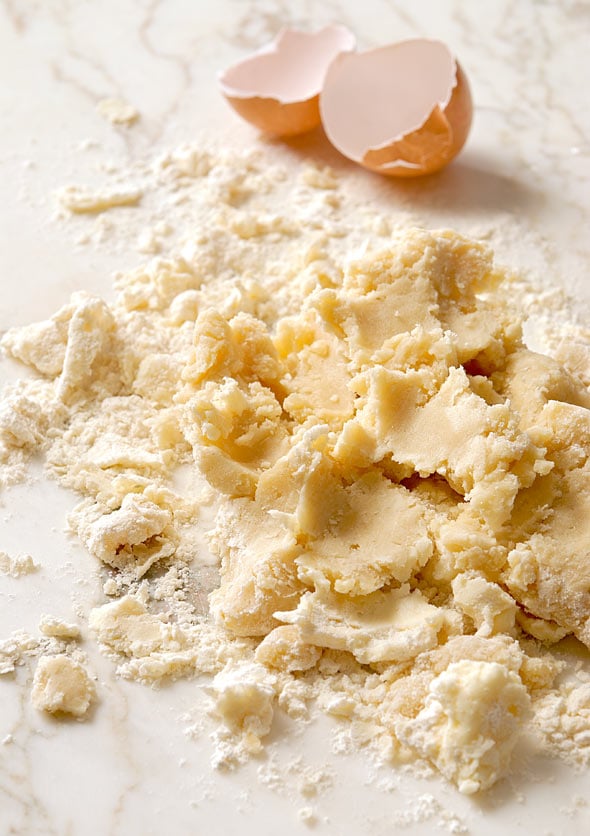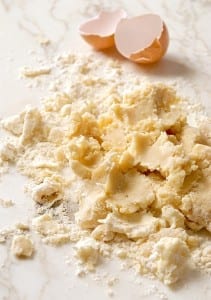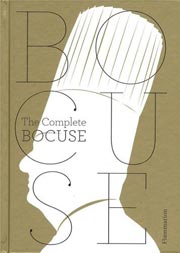
The pastry, or pie crust, known as pâte sablée is used as a base for tarts and certain desserts such as Saint-Honoré.–Paul Bocuse
LC Wait! What? Note
We’d like to expand upon the rather abridged definition of pâte sablée given above by the brilliant Paul Bocuse. It helps to understand that there are three classic quick pastries, or pie crusts, in France, of which pâte sablée is one. Pâte brisée is the basic unsweetened French pastry, or pie crust, traditionally relied upon for savory pies and tarts. Pâte sucrée is, simply enough, pâte brisée with a smidgen of sugar and, hence, appropriate for use with any sweet something.. Pâte sablée, perhaps the rarest and loveliest of the three, boasts a relatively indulgent amount of sugar along with the notable additions of egg and cream, making it the richest, sweetest pie crust known to the French. It’s also reputedly the trickiest pie crust known to the French, the ample sugar creating a more fragile dough to handle. As such, pâte sablée is often simply pressed into the tart pan by hand instead of being rolled, although, we found this particular pâte sablée to be quite a cinch to handle, actually. Despite a rather clumsy approach to getting it into the pan, the pie crust still ends up achieving a sweet, delicate, almost cookielike loveliness. Wondering what the heck to make with it? Pâte sablée is typically reserved for lightweight fruit tarts—you know, those lovely, shimmering French creations in the windows of patisseries featuring a skimpy layer of whatever fruit is in season, typically situated atop a thin schmear pastry cream and brushed with some melted preserves—so as not to overburden the delicate crust with a dense filling. Works for us.

Pâte Sablée (Rich Pie Crust)
Ingredients
- 1 pound all-purpose flour
- 2 teaspoons sea salt
- 1 heaping tablespoon granulated sugar
- 2 large egg yolks or 1 large egg
- 2 to 3 tablespoons milk, cream, or water
- 3 1/4 sticks unsalted butter, softened
Instructions
- Sift the flour onto your work surface and shape it into a mound with a well in the center. Into the well, plop the salt, sugar, egg yolks or whole egg, and 2 tablespoons milk, cream, or water.
- Using a spoon, stir the ingredients in the well until combined. Then gradually mix in the butter with the liquid ingredients in the well. Finally, using your hands, work the flour into the center of the well to combine it with the other ingredients. If necessary, add another tablespoon milk, cream, or water to create a smooth, soft dough. The dough must not be too firm. Do not overwork it, otherwise it’ll be tough. When it’s ready, the dough will be barely moistened and come together into a ball.
- Working the pie crust dough as little as possible, gently divide it into 2 equal portions and shape them into disks. Stash the dough in resealable plastic bags and refrigerate until chilled through. (Because of the copious amount of butter in the dough, it may be a little tricky to roll out. Having the dough be properly chilled through helps minimize stickiness.)
- Roll out the pie crust dough. It helps to roll it out between sheets of parchment paper or to simply forget rolling and instead press it into two 9-inch tart pans. Proceed with your preferred tart recipe.
Notes
Pâte Sablée (Rich Pie Crust) Variation
Pâte Sablée Scrap Cookies If you have any scraps of pâte sablée dough left over, reroll the the pie crust, cut into shapes, and bake on a parchment-lined baking sheet at 350°F (177°C) for about 10 minutes. Instant sugar cookies.
Nutrition
Nutrition information is automatically calculated, so should only be used as an approximation.
Recipe Testers’ Reviews
I really enjoyed this slightly sweeter, richer version of traditional pastry. With the addition of sugar, egg yolks, and heavy cream, this dough was very tasty and great as the base for a fruit tart. The pie crust recipe made enough dough for four 9-inch pies or tarts. I used 2 large egg yolks in the dough. The method suggested for the recipe was very unique and not unlike making homemade pasta dough with the “well” method. (I wonder, though, if you could place all the dry ingredients in a food processor, then add the butter cut into small pieces, then moisten with the cream until the dough just comes together? The food processor method for making dough is my favorite and is a lot easier to clean up after, in my opinion. I will have to try the food processor method with these same ingredients next time.) When making the dough, I knew it was ready when the dough was just moistened and came together in a ball. I rolled it into 4 equal-size balls and chilled them before rolling them out to press into my tart pan. I used 1/4 of the dough for a blueberry and peach tart in which I pressed the dough into a tart pan with a removable bottom and then covered it with homemade blueberry jam and sliced peaches. I had a lot of dough left over, so I rolled it into balls, flattened them into disks, and placed them in a resealable plastic freezer bag and stashed them in the freezer. A wonderful dough to keep in the freezer and defrost when a pie or tart recipe sounds appealing.
This pie crust dough has extra fat and sugar compared to a regular pâte sablée recipe, so it’s quite forgiving in terms of rolling and fitting it into a pan. I was able to just press together edges and use cut pieces to patch easily. This recipe produces enough dough for at least two 9-inch double-crust tarts. I didn’t like the counter technique for mixing this and will go back to using my stand mixer as it’s a lot faster and less messy. I made a pear tart by rolling out the dough for the bottom, placing it into an 8-inch square pan, covering it with the filling, and then topping everything with more rolled out dough. The flavor was very good, and the dough was easy to work with. I took the leftover dough scraps, pushed them together, rolled them out, and cut them into shapes. Then I put them on a baking sheet, sprinkled them with sugar crystals, and baked them for about 10 minutes. Instant sugar cookies.












I’ve had this recipe saved for some time, but finally made it. I cheated. I used cold butter and used my food processor to make the crumbly mixture. Then I dumped it on my silicone mat and made it come together. I separated into to bags. I made a sweet potato pie in a tart pan. I simply pressed the dough in. (I do love these rich crusts but they do require special handling). Always worth the trouble…but this one was effortless. My sweet potato tart was beautiful and delicious. I will make this again and again. Are you looking at this recipe and imagining possibilities but worry about the dump and mix? You can cheat, and you will not be sorry.
Leisa, I’m so delighted you liked it! And cheating is more than allowed, but only if it works!
This is NOT Pâte Sablée . It is an enriched basic Pâte Brisée… basically the ratios for the standard all purpose crust brisee enriched with the eggs or may count it a Pâte Sucrée because of the sugar, but that one usually has a bit more sugar.
Pâte Sablée is usually a 3-2-1 ratio crust, for example 300 g flour, 200 g butter,, 100g Powdered sugar with an egg or egg yolks…It is supposed to be a sweet crust…500 g flour would need 165 g sugar.
Lailabakes, agreed pâte sablée is traditionally sweeter, but it’s hard to argue with the great Paul Bocuse, one of France’s enduring culinary treasures. But thanks for your formula.